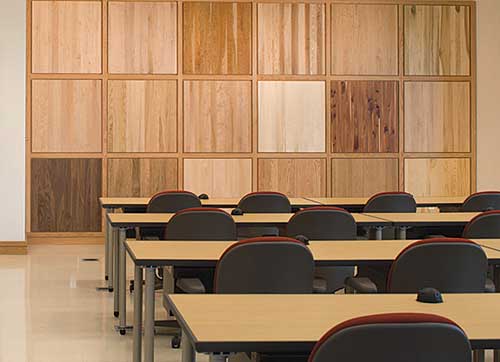American Hardwoods for High-Traffic Areas
Cherry. The heartwood of cherry varies from rich red to reddish brown and will darken with age and on exposure to light. In contrast, the sapwood is creamy white. The wood has a fine uniform, straight grain, satiny, smooth texture, and may naturally contain brown pith flecks and small gum pockets. Cherry is easy to machine, nails, and glues well and, when sanded, it produces an excellent smooth finish. Cherry is softer relatively speaking than some of the other hardwood species.
Hard Maple.The sapwood is creamy white with a slight reddish brown tinge and the heartwood varies from light to dark reddish brown. The amount of darker brown heartwood can vary significantly according to growing region. Both sapwood and heartwood can contain pith fleck. The wood has a close fine, uniform texture and is generally straight-grained, but it can also occur as "curly," "fiddleback," and "birds-eye" figure, which is generally only available in commercial volumes as veneer. The wood is hard and heavy with good strength properties, in particular its high resistance to abrasion and wear.
While hardwoods are often associated with a certain formal, elegant design aesthetic, certain species and cuts can work to achieve a more untailored look. Mainstream retailer American Eagle Outfitters, for example, uses hardwoods in all its 949 stores. "We have used oak, ash, and maple," says John Bezek, Vice President of Construction. "We typically are looking for a ‘casual' feel in our stores and the rustic or lesser grades of these species seem to fit the bill."
Subflooring
A solid hardwood floor is only as good as its subfloor. The construction of the hardwood floor, as well as the type of subfloor will determine the method of installation. Options available for subflooring include: floating floor systems, mechanically attached subflooring systems, and wood framed subflooring systems. The requirement of any subfloor is that it be clean, dry and flat.
At MoMA, a special subfloor incorporating small synthetic rubber cushions (a floating floor system) was required for strength and resilience. "One of the things we always recommend very strongly in museums-partially so people will spend more time in the museum and not complain about getting tired feet-is to put in a floating floor," says Berk. "It's basically a very sturdy version of a basketball or athletic floating floor, resilient but stiff enough to support major works of art. Berk notes the likeness to a dance floor. "But dance floors are much springier," he says. "You can actually see a dance floor deflect under the weight of a dancer. We never want that to happen here, because of the art the floor must support. But the same principle applies."
Hardwoods in Other High-traffic Applications
Hardwood applications in high-traffic areas are not limited to flooring, with designers opting to specify a variety of species for ancillary uses. Pennsylvania State University's department of forest resources celebrated its centennial in 2007 with a new $27.5 million facility for its almost 600 faculty, staff, undergraduate and graduate students in the program. The 96,000-square-foot building fully utilizes hardwood species native to the region. "Due to the nature of the project, we were very spoiled as to the amount and the quality of local hardwoods we were able to use," explains Kevin Aires, AIA LEED®, project architect at BLT Architects in Philadelphia. "Even though we had so many species available to us, we limited the wood use to three main species-cherry, ash and red oak."
|
The bulk of wood used in the high-use public spaces is cherry, which was specified for paneling, allied seating, trim and millwork throughout the facility. While ash and red oak were used for trim and paneling in the conference areas, cherry makes up most of the visually evident hardwood. "Cherry is very attractive and popular, so that's why we used so much of it in the public areas," says Aires, noting that every piece of paneling used was solid wood. Aires explains, "In terms of the solid cherry, there were really no obstacles or hang-ups other than educating ourselves as to the differences between veneer and solid wood." Since the design team was working with all-natural, non-engineered wood, the wall panels could only be as large as nature would allow. Aires contends that the limitations of the panel dimensions were not an issue. "Because all of the wood was solid, you can really see the grain. In order to highlight this aspect of the design, we went with a clear natural finish," says Aires.










